Nestled in the heart of Arkansas lies a hidden gem known as Hot Springs National Park. With its stunning natural beauty, rich historical significance, and a wide range of recreational activities, it offers something for everyone.
Introduction to Hot Springs National Park
Location and background information
Hot Springs National Park is located in the town of Hot Springs, Arkansas. It covers an area of over 5,500 acres and is situated in the Ouachita Mountains (pronounced Washitaw). The park is known for its therapeutic hot springs and lush landscapes, making it a popular destination for nature lovers and history enthusiasts alike.
Established in 1832, it is the oldest national park in the United States and is renowned for its 47 natural hot springs which flow at an average temperature of 143°F. These natural thermal waters have long been believed to possess healing properties and draw visitors from all over the world. Apart from the hot springs, the park boasts of an extensive network of hiking trails, offering stunning scenic beauty. The trails wind through lush forests, up steep hills, and along picturesque streams. Whether you are a casual hiker or an avid nature enthusiast, there is a trail suitable for you in this national park. The park also serves as a habitat for a diverse range of wildlife and boasts of a rich biodiversity. Visitors may encounter deer, raccoons, squirrels, and a variety of bird species while exploring the park. This unique combination of hot springs, stunning scenery, and abundant wildlife makes Hot Springs National Park a must-visit destination for nature lovers.
Establishment and Historical significance
Established in 1832, Hot Springs National Park holds the title of being the oldest national park maintained by the National Park Service. It was set aside to protect the unique natural resource of the hot springs, which were believed to possess healing properties by Native American tribes and early European settlers. Throughout history, these springs have attracted visitors from far and wide, making it an important part of cultural and historical heritage. In 1832 Congress, appreciating the value of these waters and recognizing the evils which might arise from their monopoly and commercial exploitation, set apart a reservation comprising four sections of land surrounding the springs and dedicated it as a national sanitarium for all time. It was our first national park.
According to tradition, the spring waters were used by the Indians long before the advent of the Spaniards. There is a tale that the various tribes battled from time to time for control of the hot waters, in which they believed the “Great Spirit” to be ever present.
The earliest story (The Hot Springs of Arkansas by [Durand, Herbert] [from old catalog]says:
“The story of the Hot Springs of Arkansas begins far back in the realms of legend and tradition, long before the white man had set foot upon the shores of the New World. The earliest explorers of the Western Continent had no sooner acquired means of intelligent communication with the natives, than they began to hear rumors and marvelous tales of a land far in the interior, where, hidden away in the deep recesses of the mountains, was a lake of hot water, fed by crystal fountains bursting from the earth, whose waters bestowed upon those who drank and bathed in them the priceless boon of health and vigor—even of eternal youth. One tradition prevalent among the Indians told how the Great Spirit came to grant this blessing to his children, the powerful nation of Kanawagas. It related that after years of prosperity and abundance, during which this tribe became mighty above the others, a terrible disease suddenly appeared in their midst, which spread with fatal rapidity. Nearly all the strong men were stricken and helpless, the hunters forsook the chase, the warpath was deserted and desolation reigned everywhere. The old and wise men said the Great Spirit was offended because in the arrogance of their power and prosperity they had forgotten and turned away from him. As nothing but pure, cool water seemed to in any measure allay their sufferings, the survivors of the tribe, as by a common impulse, dragged themselves, the stronger assisting the weaker, to a secluded valley, where the waters gushed forth in a sparkling stream from numerous springs on the mountain sides. Here they offered sacrifices and inflicted self-tortures for day after day in their efforts to appease the wrath of the Great Spirit and induce him to restore their health and strength. At last their supplications were heard. One day, just before sundown, thin wreaths of vapor were seen to issue with the water from the springs, the streamlet at their feet first became warm-—then hot. .Many thought their only means of relief was now cut off; but the wise men saw ill the wonderful transformation an end to all their afflictions. They announced that the Great Spirit had breathed his healing breath into the waters, and ordered all to bathe and drink thereof freely. This was done and the cure was marvelous and complete ; the invigorated warriors bestowing the name of “No-wa-san-lon,” or Breath of Healing, upon the springs by which name they were known forever afterward.”
Legends have it that it was the fame of these hot pools which first prompted Ponce de Leon to embark upon his romantic search for the fountain of eternal youth.
An early booklet on the National Parks says :
“But our only authentic evidence of white visitors at the springs dates back no farther than the year 1800. Two of Lewis and Clark’s explorers, branching out from the main trail of that expedition, visited the place in 1804 and found a log cabin and a few huts which had been the work of white men’s hands. Two or three years later a few scattered settlers followed the trail thus blazed. And from that time the reputation of the springs began to spread, each year adding to their fame.”
An Early Brochure (1921)seen on archive.org says:
“The reservation is the oldest national park, having received that status in 1832, forty years before the wonders of the Yellowstone first inspired Congress with the idea that scenery was a national asset deserving of preservation for the use and enjoyment of succeeding generations. No aesthetic
consideration was involved in this early act of national conservation. Congress was inspired only by the undoubted, but at that time inexplicable, natural power of these waters to alleviate certain bodily ills. The motive was to retain these unique waters in public possession to be available to all persons for all time at a minimum, even a nominal, cost.”
Then followed a generation of lax law when Hot Springs became the winter gathering place of gamblers. This was said to be the most picturesque period in its history. Hot Springs is a Government reservation under the control of the Department of the Interior.
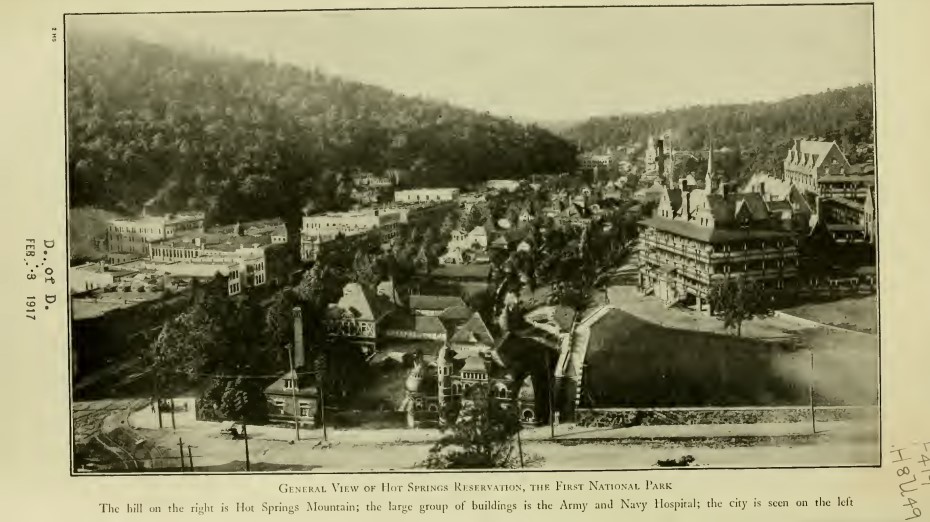
In 1919, the Hot Springs brochure says:
“On Bath House Row, the noted Midway of the place, there are ten bath-houses covering a space of about
three blocks. Besides these, there are other bath-houses in various parts of the city, some of which are operated in connection with the hotels. All use the same water and are under the same official supervision. There is also a Government free bath-house for those who are unable to pay for the service, and in connection with the Army and Navy Hospital a bath-house is maintained for the benefit of our disabled soldier and sailor boys.
Although the cures effected are sometimes almost miraculous, there is nothing extraordinary in the method of administering the bath. Equipment and appliances are better than are to be found in the average home. The tubs are large, the attendants attentive. There are needle baths and vapor baths for those who desire them, but the main object is a thorough immersion in the hot radioactive water in the tub.
When the bath has been taken, the patron proceeds from the high temperature of the first cooling room to the almost normal temperature of the last, tarrying in each of the intermediate cooling rooms long enough to avoid sudden changes. Finally comes the after-glow of the bath as he lies luxuriously upon one of the cooling room couches, conversing lazily with his fellow-patrons or simply resting.
Truly, to bathe in the waters of Hot Springs is to feel the hand of Nature in one of her most helpful moods—gentle, caressing, touching the body lightly and without inflicting the slightest pain.”
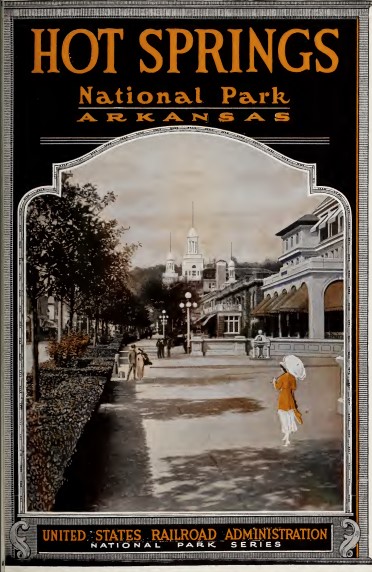
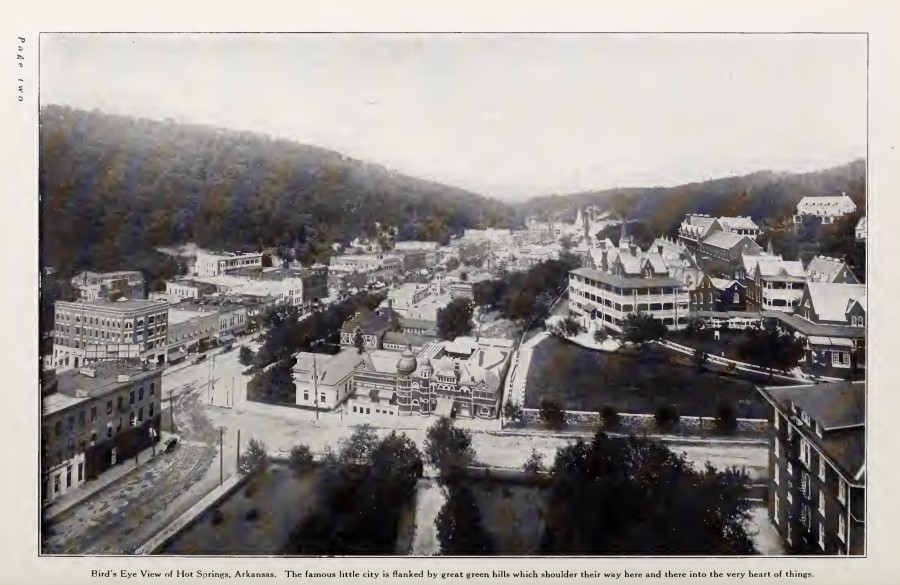
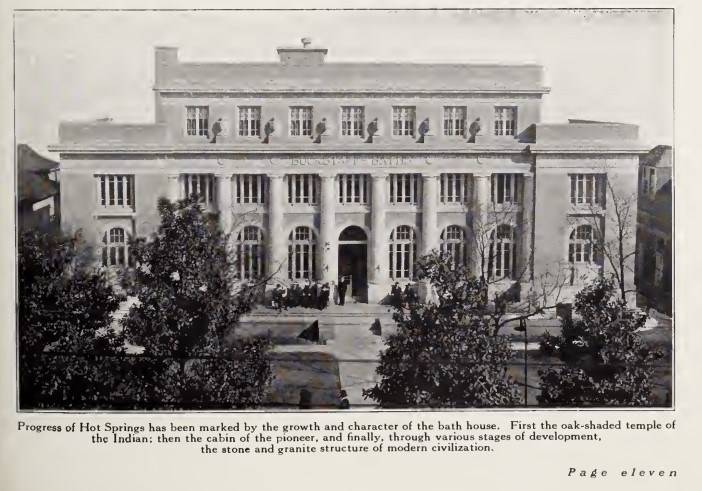
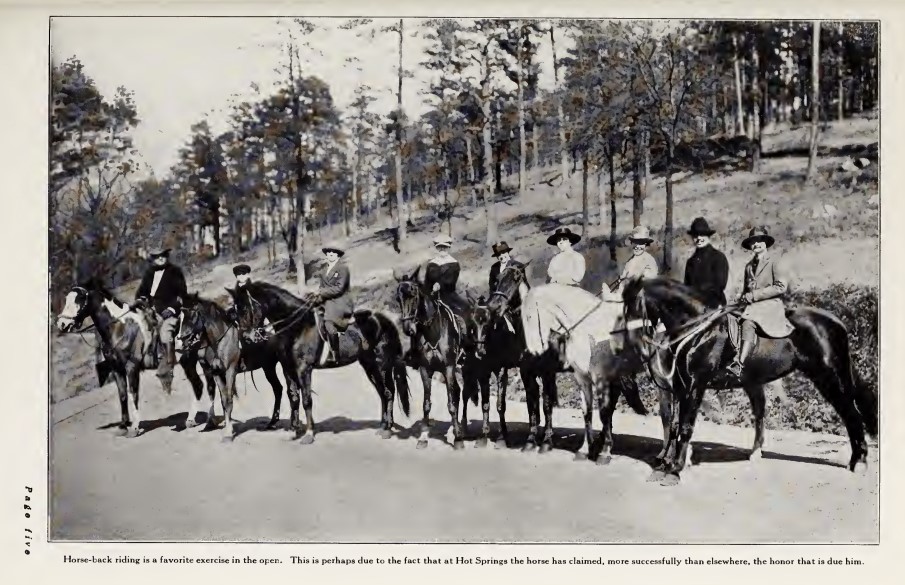
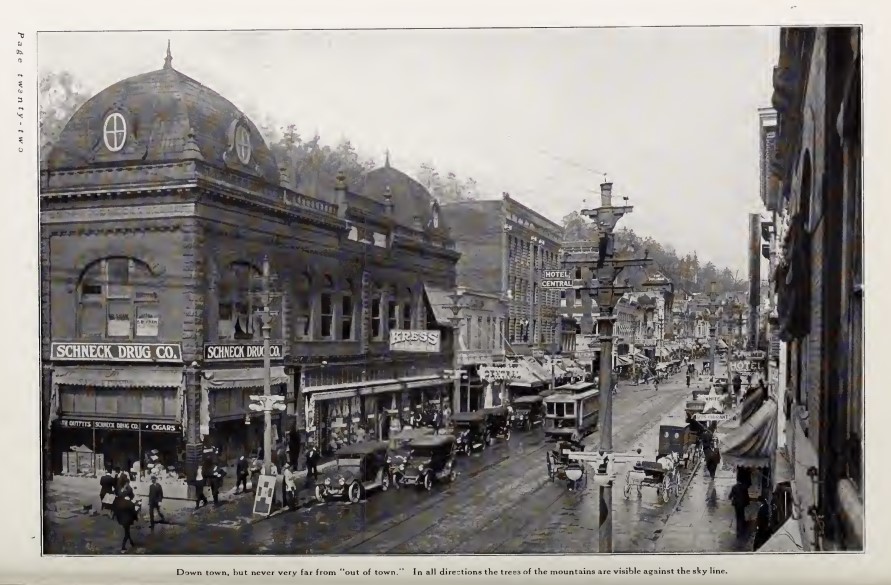
by United States Railroad Administration
Publication date 1919
The Government free bathhouse for the indigent was established pursuant to act of Congress of December 16, 1878.
The number of baths given to the poor during the fiscal year 1928 was 98,487,
The act of March 2, 1911, provides that an applicant for free baths shall be required to make oath that he is without and unable to obtain means to pay for baths, and a false oath as to his financial condition makes him guilty of a misdemeanor and subjects him, upon conviction thereof, to a fine of not to exceed $25, or 30 days’ imprisonment, or
Timeline of Historic Events (from Hot Springs National Park, Arkansas by National Park Service 1941 archive.org)
1541 Hot Springs area probably visited by Hernando de Soto and party. de Soto was an early explorer from Spain that you can learn more about on History.com
1682 Area included in land claimed for France by La Salle.
1762 Included in area given to Spain by France.
1801 By secret treaty of Madrid, area returned to France by Spain.
1803 Included in Louisiana Purchase and became United States property.
1804 Visited by Dunbar and Hunter Expedition.
1807 Manuel Prudhomme established first permanent settlement. 1820 First inn erected. 1830 First bathhouse erected.
1832 Four square miles of land, including the hot springs, set aside by the Congress, and Hot Springs Reservation created.
1874 First railroad line, the “DiamondJo,” reached Hot Springs.
1877 Hot Springs Reservation physically and administratively separated from city of Hot Springs, Ark., by Federal Survey and plotting of town site.
1884 Arch constructed over Hot Springs Greek where Bathhouse Row promenade walk now is located. 1903 Federal Registration Board established to regulate practice of physicians.
1921 Hot Springs Reservation made a national park by act of Congress. 1932 Centennial Anniversary.
Natural Features of Hot Springs National Park
Hot springs and thermal waters
The park boasts 47 hot springs, which are some of the hottest in North America. These geothermal wonders are formed when rainwater seeps into the Earth’s surface and is heated by geothermal energy. Visitors can witness these hot springs in action and even take a dip in the thermal waters for a rejuvenating experience.
Hiking trails and scenic beauty
Hot Springs National Park is a haven for hikers, with over 26 miles of scenic trails that wind through lush forests, picturesque valleys, and breathtaking mountain vistas. Whether you’re an avid hiker or a casual stroller, there’s a trail for everyone to enjoy and explore the park’s natural wonders.
Wildlife and biodiversity
The park is home to a diverse range of wildlife species, including white-tailed deer, wild turkeys, squirrels, and a variety of bird species. It also boasts an impressive array of plant life, with over 600 different species thriving in its diverse ecosystems. Nature enthusiasts will find joy in observing and experiencing the park’s rich biodiversity.
Cultural and Historical Attractions in Hot Springs National Park
Bathhouse Row and historic architecture
Hot Springs National Park is not only known for its natural beauty but also for its rich cultural and historical attractions. The park is home to Bathhouse Row, a collection of eight bathhouses built between the late 19th and early 20th centuries. These bathhouses are a testament to the park’s historical significance as a popular spa destination during the Victorian era. Visitors can explore the various bathhouses and admire the beautiful historic architecture. Some of these buildings have been converted into visitor centers or museums, providing a glimpse into the park’s past.
Visitor center and museums
The Fordyce Bathhouse Visitor Center is an excellent starting point for exploring the park. Here, visitors can learn about the history of the hot springs, the science behind their medicinal properties, and the development of the town of Hot Springs. Additionally, the park houses several museums that delve into various aspects of the park’s history, including the Gangster Museum of America and the Hot Springs National Park Museum.
Events and festivals
Throughout the year, Hot Springs National Park hosts a variety of events and festivals that celebrate the park’s cultural heritage and natural splendor. From music festivals to art exhibitions, there’s always something happening in the park that caters to different interests and tastes. These events add an extra layer of excitement and vibrancy to the park’s already captivating atmosphere.
Recreational Activities at Hot Springs National Park
Bathing and spa services
The hot springs and their therapeutic properties have made Hot Springs National Park a popular destination for those seeking relaxation and rejuvenation. Visitors can immerse themselves in the soothing thermal waters and enjoy a range of spa services offered by local bathhouses. It’s a unique and refreshing experience that should not be missed.
Outdoor activities such as camping, fishing, and boating
For outdoor enthusiasts, the park offers a plethora of activities to enjoy. Camping is a great way to explore the park at your own pace, with campgrounds available for both tents and RVs. Fishing enthusiasts can cast a line in one of the park’s many lakes and rivers, while boaters can take to the water for a leisurely cruise or an adrenaline-pumping adventure.
Picnicking and scenic drives
For a more relaxed day out, Hot Springs National Park offers picturesque picnic areas where visitors can enjoy a meal surrounded by nature’s beauty. Additionally, the park features scenic drives that wind through stunning landscapes, allowing visitors to take in the breathtaking vistas from the comfort of their own vehicle.
Importance and Preservation of Hot Springs National Park
Conservation efforts and environmental significance Hot Springs National Park has been dedicated to preserving its natural resources and maintaining its delicate ecosystems. Conservation efforts include protecting water quality, managing wildlife populations, and maintaining the park’s unique geothermal features. These efforts ensure that future generations can continue to enjoy the park’s natural beauty and historical significance.
Additionally, the park serves as a refuge for a diverse range of plant and animal species, contributing to the overall conservation of the region’s biodiversity.
Tourism and economic impact
The park’s popularity among tourists has a significant economic impact on the region. Visitors from all over the world flock to Hot Springs National Park, contributing to the local economy through accommodations, dining, and recreational activities. The revenue generated from tourism plays a vital role in supporting local businesses and the livelihoods of the community.
Educational and research opportunities
Hot Springs National Park serves as an outdoor classroom, offering educational programs and research opportunities for students and scientists alike. Whether it’s learning about the park’s geology, ecology, or cultural history, visitors can engage in hands-on experiences that promote a deeper understanding and appreciation for the natural world. In conclusion, Hot Springs National Park is a captivating destination that combines natural beauty, rich history, and a wide range of recreational activities. Whether you’re seeking relaxation, adventure, or knowledge, this national park has it all. So pack your bags, grab your hiking boots, and prepare for an unforgettable experience in Hot Springs National Park.
